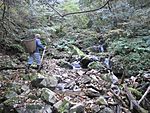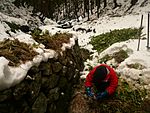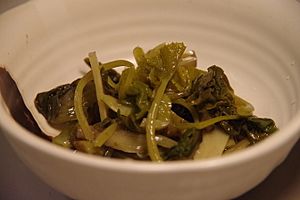Hikimi wasabi facts for kids
Hikimi Wasabi (匹見ワサビ) is a special type of wasabi grown in Hikimi Town, which is now part of Masuda City, Shimane Prefecture, Japan. It's known for its unique flavor and is quite rare today.
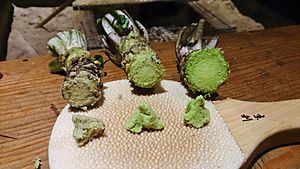
People started growing wasabi in Hikimi in 1818. By the early Shōwa era (around 1926–1989), Hikimi was producing a lot of wasabi, about 300 metric tons (which is 330.7 US tons) each year! At that time, 90% of all wasabi from Shimane Prefecture came from Hikimi. Shimane was one of the top wasabi-producing areas in Japan, along with Shizuoka Prefecture in the east.
However, Hikimi's wasabi production has gone down a lot. This happened because of big floods in the 1970s, younger generations choosing different jobs instead of farming, and even global warming. In recent years, some new people who moved to Hikimi are trying to bring back wasabi farming. In 2013, Shimane Prefecture produced only 74.5 metric tons of wasabi. This makes it the fifth-largest producer in Japan, but it's much less than the top three prefectures: Shizuoka (867.6 metric tons), Nagano (604.7 metric tons), and Iwate (432.7 metric tons). Because of this smaller amount, Hikimi wasabi is now considered quite rare.
Contents
Why Hikimi is Great for Wasabi
Japan, except for the Hokkaido area, has a special climate with lots of water, even though it's at a latitude where deserts are common in other parts of the world. In winter, rain often turns into snow. The side of Japan that faces the Japan Sea gets a lot of snow, more than almost anywhere else at the same latitude.
Hikimi is located in the snowy part of Japan. Snow helps wasabi plants in a few ways:
- It acts like a warm blanket, protecting the wasabi from freezing in winter.
- It melts slowly, providing a steady supply of water, which wasabi needs to grow well.
Hikimi is also very humid and, being in the mountains, gets fewer hours of sunlight throughout the year. Wasabi is a plant native to Japan and grows best in places with high humidity and less direct sunlight, not in very sunny or hot areas. All these natural conditions make Hikimi a perfect place for wasabi to grow naturally.
Challenges for Wasabi Farming
Even though Hikimi's climate is great for wasabi, there are worries about its future. The temperature in Hikimi has risen by 1.1 °C (1.98 °F) in the past 100 years. This is faster than the global average. This means that the ideal growing conditions for wasabi have moved higher up the mountains. In the past, farmers could grow top-quality wasabi in lower areas.
However, since World War II, the water temperature has slowly increased. Warmer temperatures mean more insects that can harm the wasabi plants. Some farmers are trying to move their farms to higher elevations to avoid these problems, but they are running out of suitable land. Also, in recent years, the Japan Sea side of Japan has experienced very heavy rainstorms. These huge storms can wash away wasabi plants and even destroy entire farms.
How Hikimi Wasabi is Grown
Growing Wasabi in Water
In Hikimi, wasabi is often grown in water using a method called Keiryū style (渓流式, meaning "mountain–stream style"). The water comes from the Takatsu River system, which is one of the cleanest rivers in Japan.
Other wasabi farming styles, like those in Shizuoka or Nagano, often use spring water and are built on a large scale with big machines. But Keiryū-style fields are built by hand along mountain streams. They are smaller and use the natural shape of the land. To reach these Keiryū-style fields, farmers need to be excellent mountain hikers because the fields are often in hard-to-reach places.
Special Qualities of Water-Grown Wasabi
Slow Growth
Wasabi grown in the Keiryū style grows slowly because it's very connected to nature. Spring water from underground usually stays the same temperature all year. But mountain stream water is open to the air, so its temperature changes easily with the weather.
Wasabi needs water temperatures between 8 to 18.6 °C to grow (the best temperature is 12 to 13 °C). If it's too hot or too cold, the wasabi stops growing. So, water-grown wasabi in Keiryū-style fields grows and rests in cycles, much like the growth rings you see on trees.
Flavor and Look
Hikimi wasabi has a special taste and look:
- It has a sharp, spicy flavor that is followed by a mild sweetness.
- It has a rich smell and a sticky, thick texture.
- When grated, it's light green. (Local types are often yellow or white.)
A famous chef once said that Hikimi Wasabi has sweetness in its spiciness because it spends time growing in the snow. He compared it to Japanese radish (daikon) that is kept in snow, which also becomes sweeter.
The sticky texture of Hikimi wasabi helps it keep its spicy flavor and smell longer after it's grated. It also works well as a topping for sushi. For example, if you put slippery toppings like herring roe on sushi rice, they might slide off. But wasabi makes the toppings stick better, and Hikimi wasabi's stickiness is especially good for this.
When it comes to color, people in Tokyo like the dark green wasabi from Shizuoka Prefecture. But people in the Kyoto–Osaka–Kobe area prefer the lighter green wasabi from Shimane Prefecture. Big companies that make processed wasabi even sell two different colors of powdered wasabi: one for western Japan (lighter) and one for eastern Japan (darker).
Growing Wasabi on Farms
Wasabi is also grown on farms, mostly on the slopes of forests where broad-leaved trees grow. These trees are helpful because they block strong sunlight in the summer, giving the wasabi the right amount of shade. In winter, when their leaves fall, they let weaker sunlight through.
These farms are built at different heights, from 250 meters to 1100 meters above sea level. By farming at various altitudes, farmers can harvest wasabi over a longer period of time.
Bringing Wasabi Back
To help wasabi farming in Hikimi grow again, a few things are happening:
- An institution now grows young wasabi plants of strong types. It has special labs to control the air and keep out bacteria.
- The local government has a plan to get people interested in farming and living in the countryside. They want to find new farmers and encourage people to move to Hikimi. Some people who joined this program have even moved to Hikimi to become farmers.
Gallery
- Growing Hikimi Wasabi
Types of Hikimi Wasabi
Shimane No. 3 is a main type of wasabi grown in both water and soil fields. It was created in 1942 by Dr. Yokogi Kuniomi and a farmer named Kenjirō Tanaka. This special type of wasabi can resist a disease that destroys wasabi plants, and it helped save the wasabi industry in Shimane Prefecture.
For wasabi grown in water, besides the types native to Hikimi, there's also Daijin. This type comes from native wasabi varieties found in other parts of Japan.
Misawa is another type of wasabi that was developed in 2002, and it is used only for wasabi grown in soil.
Wasabi Products
Water-grown wasabi is used to make many products, like wasabi paste without extra ingredients, Japanese yam paste mixed with wasabi, and even sausages with wasabi!
Wasabi grown in soil is mostly used for wasabi paste. But its leaves, stems, and flowers are also used to make pickled foods. These include shōyu-zuke (pickles in soy sauce), sakekasu-zuke (pickles in leftover sake ingredients), and miso-zuke (pickles in miso paste). You can even find wasabi in sweets like ice cream and pudding! The young shoots of wasabi, known locally as ganime, are especially prized for shōyu-zuke because of their good texture.
Wasabi Culture
Yamaaoi-Tengu-Sha Shrine
The Yamaaoi-Tengu-Sha shrine is the only shrine in Japan dedicated to wasabi. Wasabi farmers go there to pray for a good harvest. The shrine is located high up on Mount Daijingataki, in Hikimi. This area is thought to be where Hikimi Wasabi first started. The main object of worship at the shrine is a carved tengu (a mythical creature) holding a round fan.
Wasabi Kagura
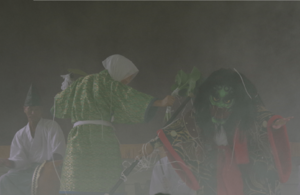
Iwami Kagura is a traditional dance and music performance from western Shimane Prefecture. People in Hikimi created a special Kagura play to pray for good wasabi harvests. A local artist made the wooden masks, a researcher wrote the story, and a group of wasabi farmers created the dances.
The play is called "Yamaaoi Tengu," named after the Wasabi Shrine. It was first performed at the shrine on June 5, 1983, and has been performed ever since. The story shows a tengu, who is the spirit of the shrine, fighting off diseases and insects (shown as human-like demons) to save the struggling wasabi farmers. The Mikazura Kagura Preservation Society, made up of wasabi farmers, performs this story. Their performances are recognized as an important cultural treasure of Shimane Prefecture.
Uzume-meshi
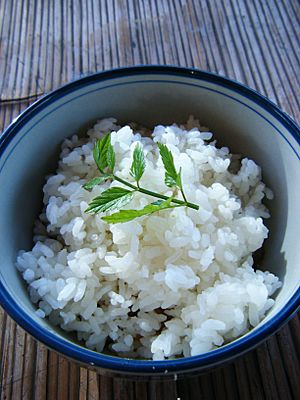
People in Hikimi have been eating dishes with wasabi since the Middle Ages. One very famous dish is uzume-meshi. It was even chosen as one of the "Five Great Japanese Rice Meals" in a national survey!
Uzume-meshi looks like a simple bowl of rice. But when you move the rice with your chopsticks, you find chicken, taro, burdock, carrots, nameko mushrooms, and other ingredients hidden in a broth underneath! The word uzume means "to fill up" or "to hide," and meshi means "rice." So, the dish is named after how the ingredients are hidden.
In Hikimi, Uzume-meshi was often served at special gatherings, like when important guests visited, during festivals, or for New Year's. No one knows exactly how it started, but there are three main stories:
- Long ago, wasabi was so expensive that selling just a little could support a farmer for a month. So, they hid the wasabi under the rice so guests wouldn't feel bad about eating such a costly food.
- Hosts might have been embarrassed to serve simple vegetables on top of rice, so they hid them.
- In ancient times, copper pheasant was a source of protein. During the Edo period, a rule came out against harming living things. So, people started hiding the ingredients under the rice to avoid getting into trouble.
The ingredients in uzume-meshi can change depending on the home or restaurant, but it always has rice mixed with broth and wasabi. You can find uzume-meshi at local restaurants and even at a rest stop during the Masuda I・NA・KA Ride, a local bicycle race. This dish also appeared in the Japanese comic series Oishinbo.
Wasabi Mascot
In 2011, a mascot named Wasamaru was created to help promote people moving to Masuda city. Wasamaru is shaped like a wasabi plant!
Images for kids





